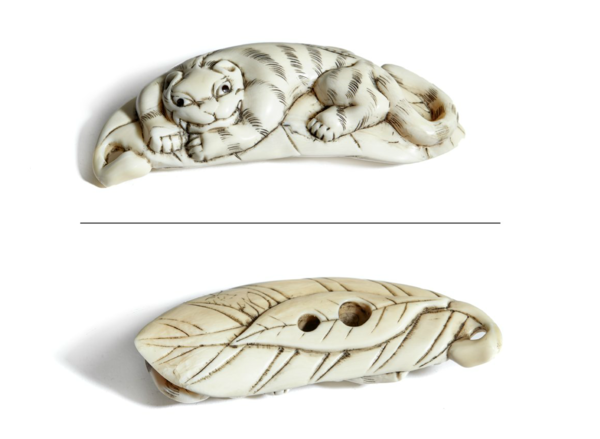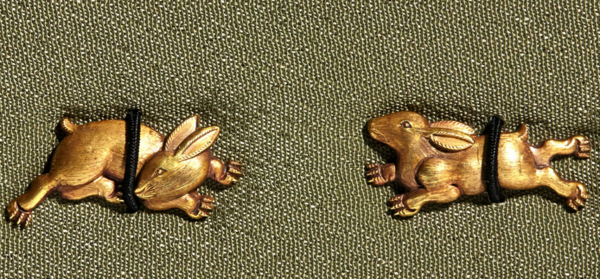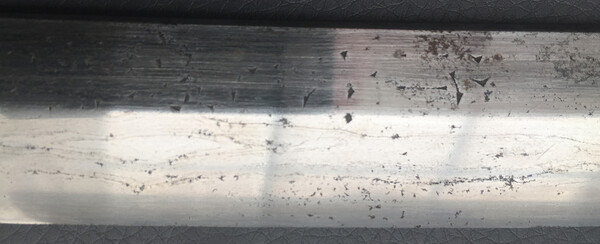-
Posts
216 -
Joined
-
Last visited
Everything posted by Gasam
-
Thank you as always people. Skipping on this one then! Cheers,
-
Heyas, Might have an option on this Netsuke for about USD 300. Little longer than 2 inches. Knowing nothing of Netsuke, I am of course looking to check if anyone knowledgeable would consider this a good deal :-) Do I see a mei-like scribling top left quadrant of backside Picture? Also, can anyone see offhand if this is Ivory. Seller doesnt state. Cheers,
-

Possible The Finest Sword With A Hefty Pricetag!
Gasam replied to Viper6924's topic in General Nihonto Related Discussion
Heyas, There is a movie on youtube (Im sure a number of you have seen it, I know it has been mentioned on these forums) of a modern smith forging a sword for a shrine. He aims to recreate a choji hamon. He does so without any clay. The first attempt at yaki-ire leaves part of the blade with a weak hamon, so the guy simply reheats and quenches again, this time to his satisfaction. I am on vacation now, almost no internet, so cannot research where I saw it. but I was always intrigued since seeing this film that a hamon could be achieved without clay. Cheers, Edit: could it have been the sword episode of "begin japanology" with peter barakan? -
Haha some friends of mine tried to just drop in there without reservation last year during the world fullcontact karate championship. They were politely turned away :-) Great film. Would be scared to eat there though. He studies you so while you eat, I would be worried to do something wrong :-) Cheers,
-

Possible The Finest Sword With A Hefty Pricetag!
Gasam replied to Viper6924's topic in General Nihonto Related Discussion
How, just freaking how did they do that? What ungodly level of control was needed for this to come through I wonder. That hamon is... almost an impossibility, to my mind at least. Thanks for sharing :-) Cheers, -
Heyas, Excellent stuff guys, thanks again Cheers,
-
Heya guys, Thank you both, it is mush appreciated. Piers: I suppose when I start thinking about it, the hozon paper would just state a description. I guess I kind of knew that, but was hoping for some light shed on the yasutsugu inscription :-) Guess my enthusiasm got in the way of better thinking. Wont be the last time Im afraid :-) John: Thank you very mush for your efforts :-) . Again, it is much appreciated, I can not overcome this translation alone by any means. To all: Piers have reminded me that hozon certificates does indeed not try to explain the things we are required to research ourselves. Since the Kampei passed Hozon, we can think that the certificate simply describes the tsuba, and certifies it as shoshin. Therefore, translation is really not necessary. The same could go for the eagle tsuba, but now I think we have two possible translations of mei: Enju Saku (from the original thread) and Nobu Toshi Saku (from John above). If we can verify mei in certificate, we can also halt translating on the eagle tsuba :-) Once again, thank you for efforts. I really cannot thank you folks enough for using your time on this. Cheers,
-
Heyas. I have two hozon certificates that I just got back from Japan. The respective items were discussed in some detail here: http://www.militaria.co.za/nmb/topic/18504-a-strange-tsuba-to-me-at-least/ and here: http://www.militaria.co.za/nmb/topic/18474-kanji-iron-tsuba-deciphered-some/ Now of course I am dying to know what they say. In particular there were some wondering in the thread about the Enju Saku one with the Yasutsugu signature also present, what this could be/mean. No small thing to ask, I realize clearly, so in an effort to even things out a little I have made a donation to the board of US$ 30, 15 for each origami. Even if these should never get translated, the board is certainly worth donating to anyways :-) I have all the time in the world so no hurries :-) Cheers,
-
Cheers for the board! And indeed its owner and tireless moderators. How many times has the collective knowledge of this board come to my aid? Countless times. I foresee that when we are all gone, collectors of the future will search the arcane archives of this board, searching for knowledge. Barrys idea is excellent, donation made. Cheers!
-
Thanks guys as usual, And Grey you are indeed correct, a hamon but nothing special (at leat nothing special I can see :-) Thanks again and Cheers
-
I think you might very well be right :-) Would such item be hardened usually? This piece has a hamon, but I Guess compared to work of hammering it out, doing a half baked yaki-ire is not much work just for getting the hamon in. Cheers,
-
Heyas again, Some pictures as promised. Sorry for delay, much going on in weekend :-) So basically does not look like tanto nakago I have seen before. Is it a Kaifu trait maybe that sometimes they did this? I have not seen it in other Kaifu though. Perhaps it has been a naval dirk as mentioned? Could have been altered I guess. Habaki snug fit, absolutely made for the blade I believe. At any rate, ucikoed, oiled and kept as is :-) Cheers,
-
Hey. That also is a question I had. It is a miniature version of a nakago, not at all what I expected to see as tsuka was removed. As long as you would ecpect but thinner, like can be glippsed in photo. Well formed as such, but looks more like sword nakago than a tanto one., habaki and tsuka clearlymade for it, but strange. I think maybe Meiji. At any rate, blade is signed on the blade itself, one side flat, the other has ridge line. So kaifu-school? Could be tourist thing. Will post some more pics laters. Cheers,
-
Heyas I had decided against buying this around 30 cm tanto, but had it thrown after me in the end with another purchase. It was (is) in a sorry state. No features visible, 100% out of polish, lots of dark surface oxidation but no red rust. In particular, the mune seems to have been beaten with hammer or similar. Presumeably to cleave something with it. One big hakobore, some smaller ones. Many many microscratches.. But what annoys the most: look at the grind mark close to the hamachi....who does this? Looks like the marks from one of those horrid electric kitchen knife "sharpeners" they sell. Oh, the humanity! On the brighter side, as I uchiko away (sorry Darcy :-) ), the hamon and some features comes through. In particular, what I thought to be oxydation specks now shines markedly in the ha. They were dark, now they shine a little. So it must be feature of hamon. Maybe aranie? At any rate, this blade will be oiled and kept as is. (is the plan at least). Maybe not so much purpose to this post, but seeing the grinding marks just ...arghhhh, had to share. Better to get it out :-) Cheers,
-
"Encyclopedia Hallamica" How many volumes would that be I wonder :-) Thanks for sharing, it will be interesting coffe times at my coin collecting friend when I tell him of this :-) Cheers,
-
Haha good point! While we are on that subject of detailed engravings, a friend of mine collects ancient coins. Turns out nobody really knows how the ancient romans, greeks etc were able to engrave the striking dies with such small detail. Theories range from looking at work through water drops to simply hiring extremely nearsighted people. Nobody knows :-) But digression :-) kind of. Edit: the water drops they think might be accumulated on leaves etc. Kinda hard to look through a falling drop :-) Cheers,
-
Hi again, Thanks for input, I really appreciate it :-) I think I will have these submitted for shinsa. They are quite small (just over 2 cm, little under an inch) long. So the detail in the first picture are really, really tiny. How someone had the eyesight to make this is just Incredible....
-
Heyas, Not the best of Pictures (i blame mobile phone), but basically they are both like this on the backside. No signature as expected. Cheers,
-
Thanks guys, Will post upon arrival, might be a few days :-)
-
Heyas, Was able to get these Menuki. Described as circa 16k gold, possibly late 1800s by antiques dealer, but they are guessing on both (is my guess at least). I quite like them, they seem both detailed and simplistic somehow, to my eyes at least. Will be interesting to see backside when they arrive. Perhaps there will be a mei, although I understand it is not so common on menuki. If anyone recognize this as a style of a certain school or artisan, please don´t hesitate to comment (or indeed comment on any aspect of these it you want ). Still very much a learner in the field of tosogu :-) Cheers,
-
Thank you all again. Kaifu school it seems then, and something new learned once more in the world of nihonto and these fine forums :-)
-
Thank you both, will check out the links :-)
-
Hi all, My friend who is visiting his old home town during the summer brought over an old blade. Its current home is his mothers sewing-cabinet, and has been so for many years. My friends family is (or rather was) one of sailors. He suspects this sword was brought to Norway by his grandfathers brother. When his ship left Japan a long time ago, he missed it because of a romantic involvement with a Japanese woman. He had to stay in Japan for a long time before the ship returned from Europe :-) This was before WWII, my friend believe it was in the 1920s or 30s. At any rate, the sword has an unusual shape I have only seen in tantos before (katakiriha-zukuri), but in this blade ridge line further away from ha than in the tantos I have seen with this shape. One side is alsolutely flat, the other side has a shinogi, but no yokote. Hada is o-mokume (as far as I can see). Polish is too old to see the hamon, but I can clearly see the metal changing color, the shape seems to be something like a suguha hotsure. I can see no boshi. Nakago seems ubu, but mumei. It has what I would say is Fumbari towards the machis. It seems to be more pronounced in hand than in the pictures. Length is 43.3 cm, so wakizashi size. It is very light, so when he held my shinshinto wakizashi later he immediately remarked how heavy it felt. The sword is tired. There are several openings etc, and the sword is thinner (markedly) on the blade than on the nakago. My friend believed the sword was battle-scarred because of markings on the blade, but surely those must be polished-down kanji. they are shown in one picture. I have tried briefly to check for wakizashis of this shape, but found none. I have oiled the blade and advised him to keep it in shirasaya and not touch it anymore with fingers. Advised against all kinds of polishing attempts etc, also Japanese polish (blade too tired I think). But does anyone have any examples of this shape in wakizashis? I would like to be able to tell him an approximate age at least. It could be meiji tourist crap, but shirasaya is good work, and surely with this many polishes, there could be some age to this blade? PS: there looks like hakobore in one of the pictures. This is the crappy phones fault. Ha is good and still decent sharp :-)
-
Heyas again: Update: This tsuba too, was able to pass NBTHK Hozon shinsa. Papers are pending. It was not submitted for TH. A big thank you once again to all that contributed above :-)















